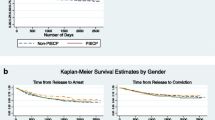Abstract
Prison labor has both positive and negative effects. Keeping prisoners active, training and socializing them to be productive citizens after prison, and helping to pay for their incarceration are some of the positives. Potential crowding out of free labor and industry is the major potential negative. This paper addresses the quantitative financial and employment consequences on local free labor and industry of prison industries in Ohio using an input–output model for Ohio. Based on the analysis, prison industries employment in Ohio has negligible to positive employment consequences for the Ohio economy and partially offsets the incarceration cost of the inmates who participate – providing between 5 and 10 percent of the incarceration cost in net cash flow and induced tax revenues.
Similar content being viewed by others
References
Flanagan, T. J.; Thornberry, T. P.; Maquire, K.; McGarrell, E. “The Effect of Prison Industry Employment on Offender Behavior: Final Report of the Prison Industry Research Project,” Albany, New York: The Hindelang Criminal Justice Research Center, State University of New York at Albany, January 29, 1988.
Grieser, R. C. “Do Correctional Industries Adversely Impact the Private Sector,” Correctional Industries, 1989, pp. 18–24.
Harrison, P. M. “Prisoners in 2002,” available at http://www.ojp.usdoj.gov/bjs/prisons.htm, 2003.
Korpi, K. “Re: Prison Industry Enhancement Certification Guideline [OJP(BJA)-1150],” Letter from the Director of Department of Research and Collective Bargaining Services, AFSCME, to Bureau of Justice Assistance, Office of Justice Programs, September 8, 1998.
Marshall, R. “Preliminary Opinion on Inmate Labor Participation,” National Symposium on the Economics of Inmate Labor Force Participation, George Washington University, Washington, District of Columbia, May 21, 1999.
Maryland Division of Corrections. State Use Industries Annual Report FY 2001. September 1, 2001.
Reynolds, M. “Factories Behind Bars,” NCPA Policy Report no. 206, 1996.
Schwalb, S. “The State of Correction,” Proceedings of the American Correctional Association Conference, American Correctional Association, 1994.
Scott, C. E.; Derrick, F. W. “Prison Labor Effects on the Unskilled Labor Market,” American Economist, 48 (2), Fall 2004, pp. 74–81.
—. “Prison Labor and Education Program Effects on Recidivism.” Unpublished Working paper, 2005.
Yae, M. “An Analysis of Correctional Industries Programs,” Corrections Today, 61 (6), 1999, pp. 94–97.
Author information
Authors and Affiliations
Corresponding author
Rights and permissions
About this article
Cite this article
Scott, C.E., Derrick, F.W. Prison Labor: The Local Effects of Ohio Prison Industries. Int Adv Econ Res 12, 540–550 (2006). https://doi.org/10.1007/s11294-006-9051-1
Received:
Revised:
Accepted:
Published:
Issue Date:
DOI: https://doi.org/10.1007/s11294-006-9051-1




